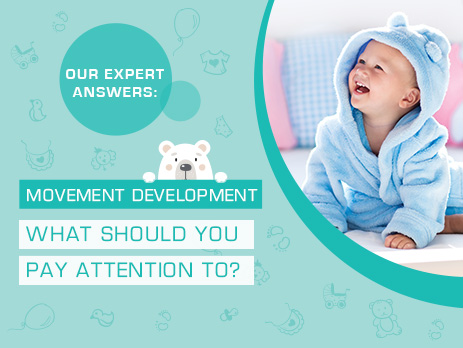Stages of motor development – What should you pay attention to?
IN THIS ARTICLE:
Why is motor development important in the first year?
Developmental stages
The pace of motor development
Understanding the key milestones of a baby’s motor development is essential, as significant changes occur throughout the first year of life. With insights from Dr. Tibor Kovács, an experienced pediatrician, we will explore the different phases of motor development, including exercises to support progress and ways to address potential challenges.
The importance of motor development in the first year
Motor development during a baby’s first year is crucial, as it lays the foundation for future physical abilities. It is essential to monitor each stage of development, from exploring their surroundings, lifting their head, rolling over, crawling, sitting, and standing to eventually walking.
Babies undergo an extremely rapid developmental process during their first year, with significant progress occurring even in the first few months.
Babies undergo an incredibly rapid developmental process in their first year, with significant progress occurring even in the first few months. A newborn’s muscle tone is very characteristic. Their flexor muscles are more active than the extensor muscles, which results in their arms and legs remaining slightly bent while lying down. When placed on their stomach, they tend to pull their legs under themselves, slightly raising their bottom.
- First Weeks: In a prone position, the baby slightly lifts their chin. Initially, they do not follow visual stimuli as effectively, but they can focus on objects about 20 cm away.
- Between 1-2 Months: Their gaze-following ability improves, progressing from 45 degrees to 90 degrees, and eventually 180 degrees as their vision develops.
- At 2 Months: Babies begin to make sounds and consciously smile at their parents. This marks a dynamic transition from the newborn stage, as they begin displaying new expressions, sounds, and movements almost daily.
- At 3 Months: They start to explore their hands, often putting them in their mouths, which is not necessarily a sign of teething but rather a sensory exploration process. When placed on their stomach, they lift their head more stably and can support themselves on their forearms with open palms.
- At 4-5 Months: They begin playing with their feet, reaching for them while lying on their back. In a prone position, they extend their arms and lift their chest while supporting themselves on their open palms.
- At 6-7 Months: After mastering rolling over, they start crawling, which lays the foundation for the next stage—creeping on all fours.
- At 8-9 Months: Following crawling, they start climbing and standing with support, gradually increasing their ability to maintain balance for a few seconds.
- At 12-15 Months: The baby starts taking a few steps while holding onto furniture and, between 1 and 1.5 years, begins independent walking.
Every child develops at their own unique pace, but there are general milestones that provide guidance on what to expect. It is crucial to support your child’s motor development through proper encouragement and a safe environment.
For each major motor skill, there is an accepted timeframe within which it is natural for a child to learn a particular movement. As long as their progress falls within this range, there is no need for concern. However, if development falls significantly outside of this period, it could indicate a delay.
Additionally, skipping, reversing, or improperly executing a movement may also signal a developmental issue. If you notice any unusual patterns in your child’s motor development, it is advisable to consult a pediatrician or health visitor.
Fortunately, there are many ways to support and facilitate healthy movement development, including physiotherapy, targeted exercises, and play-based activities that help strengthen coordination and motor skills.





